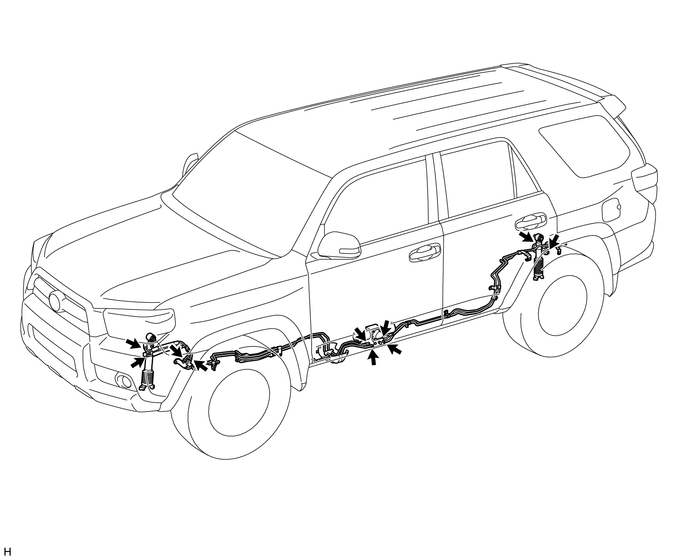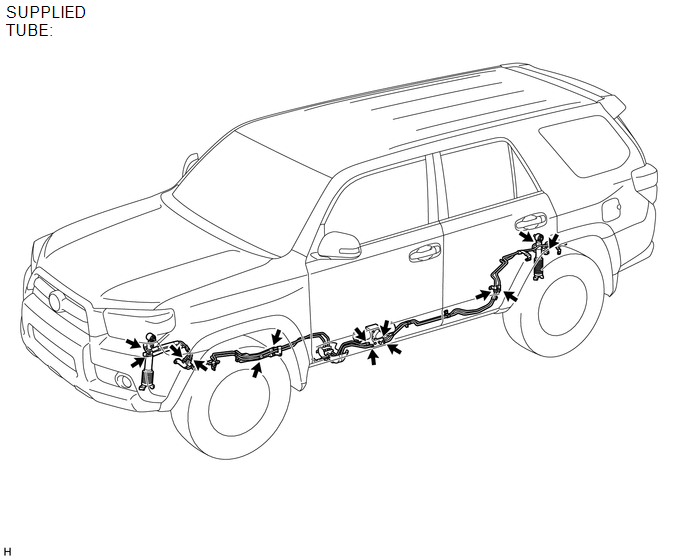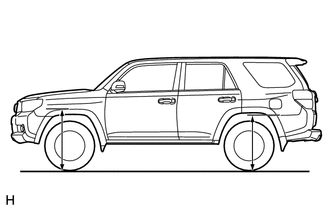Toyota 4Runner: On-vehicle Inspection
ON-VEHICLE INSPECTION
PROCEDURE
1. INSPECT VEHICLE HEIGHT
NOTICE:
- Perform the calibration on a level surface.
- Perform the calibration with the vehicle empty.
- Make sure that the wheels are on the ground and facing straight ahead.
- Perform the calibration with the vehicle load completely on the suspension.
(a) Set the tire pressure to the specified value(s) (See page
.gif) ).
).
(b) Bounce the vehicle to stabilize the suspension.
|
(c) Measure the distance from the ground to the top of the bumper and calculate the difference in the vehicle height between the left and right sides. Perform this procedure for both the front and rear wheels. Height difference of left and right sides: 20 mm (0.787 in.) or less HINT: When the difference in vehicle height between the left and right sides
is outside of the specification, perform air bleeding (See page
|
|
2. INSPECT FOR SUSPENSION FLUID LEAK
CAUTION:
Fluid is pumped into the system at a high pressure of approximately 3 MPa (30.6 kgf/cm2, 435 psi). If a fluid leak is discovered, immediately release the pressure and repair the fluid leak.
(a) Perform a driving test.
(b) Check for fluid leakage from the parts and connections shown in the illustration.


 Problem Symptoms Table
Problem Symptoms Table
PROBLEM SYMPTOMS TABLE
HINT:
Use the table below to help determine the cause of problem symptoms. If multiple
suspected areas are listed, the potential causes of the symptoms are listed in order
...
 Bleeding
Bleeding
BLEEDING
PROCEDURE
1. BLEED AIR FROM SUSPENSION FLUID
CAUTION:
Be sure to check the pipe connections and whether or not any hydraulic
circuit parts are damaged before performing work a ...
Other materials about Toyota 4Runner:
Trailer Tongue Weight
• A recommended tongue weight varies in accordance with the types of trailers
or towing as described below.
• To ensure the recommended values shown below, the trailer must be loaded by
referring to the following instructions.
• Tongue Weight The g ...
Unlock Warning Switch
Components
COMPONENTS
ILLUSTRATION
Removal
REMOVAL
PROCEDURE
1. REMOVE LOWER STEERING COLUMN COVER
2. REMOVE UPPER STEERING COLUMN COVER
3. REMOVE WINDSHIELD WIPER SWITCH ASSEMBLY
4. REMOVE UNLOCK WARNING SWITCH ASSEMBLY
(a) ...
0.0068

